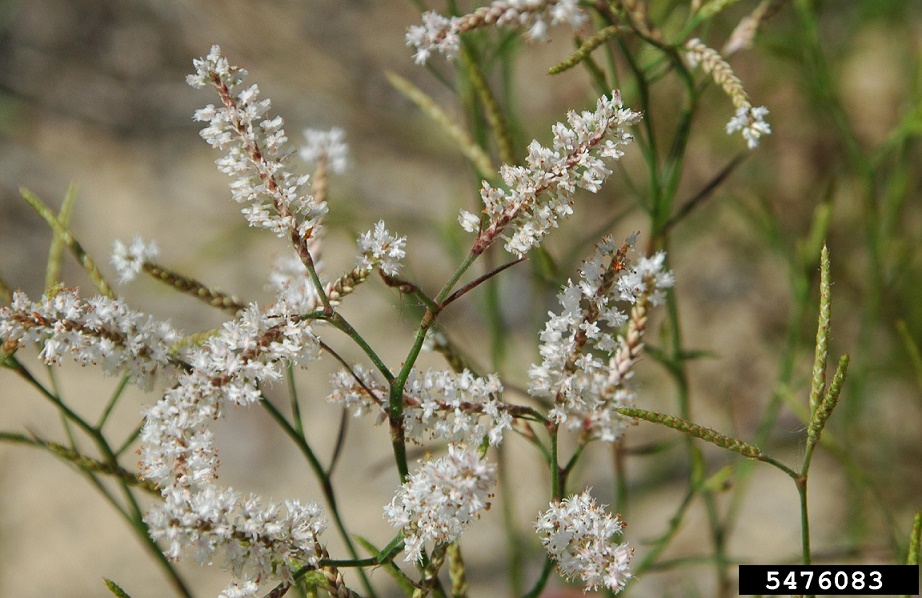Difference between revisions of "Polygonella polygama"
KatieMccoy (talk | contribs) |
KatieMccoy (talk | contribs) |
||
| Line 31: | Line 31: | ||
==Ecology== | ==Ecology== | ||
===Habitat=== <!--Natural communities, human disturbed habitats, topography, hydrology, soils, light, fire regime requirements for removal of competition, etc.--> | ===Habitat=== <!--Natural communities, human disturbed habitats, topography, hydrology, soils, light, fire regime requirements for removal of competition, etc.--> | ||
| − | In the Coastal Plain in Florida, ''P. polygama'' can occur in seasonally wet depressions with ''Hypericum tenuifolium'' and ''Paronychia chartacea''; and in xeric oak/saw palmetto scrubs. In disturbed areas it can be found in roadside ditches, clear-cut slash pine forests,wooded beach dunes; and dry sandy spoil material that has been pumped from the river during dredging operations | + | In the Coastal Plain in Florida, ''P. polygama'' can occur in seasonally wet depressions with ''Hypericum tenuifolium'' and ''Paronychia chartacea''; and in xeric oak/saw palmetto scrubs. In disturbed areas it can be found in roadside ditches, clear-cut slash pine forests,wooded beach dunes; and dry sandy spoil material that has been pumped from the river during dredging operations<ref name="FSU">Florida State University Robert K. Godfrey Herbarium database. URL: [http://herbarium.bio.fsu.edu http://herbarium.bio.fsu.edu]. Last accessed: October 2015. Collectors: Loran Anderson, Wilson Baker, Angus Ghloson Jr., Robert K. Godfrey, Ann Johnson, Robert L. Lazor, Cecil R. Slaughter. States and Counties: Florida: Bay, Franklin, Holmes, Osceola. Compiled by Tall Timbers Research Station and Land Conservancy.</ref>; Looney and Gibson 1995). Associated species include ''Liatris laevigata, Hypericum tenuifolim, Paronychia chartacea'' and ''Palafoxia integrifolia''. Soil types include white sand and loamy sand (FSU Herbarium). |
===Phenology=== <!--Timing off flowering, fruiting, seed dispersal, and environmental triggers. Cite PanFlora website if appropriate: http://www.gilnelson.com/PanFlora/ --> | ===Phenology=== <!--Timing off flowering, fruiting, seed dispersal, and environmental triggers. Cite PanFlora website if appropriate: http://www.gilnelson.com/PanFlora/ --> | ||
| Line 65: | Line 65: | ||
==References and notes== | ==References and notes== | ||
Deyrup, M.A. and N.D. 2015. Database of observations of Hymenoptera visitations to flowers of plants on Archbold Biological Station, Florida, USA. | Deyrup, M.A. and N.D. 2015. Database of observations of Hymenoptera visitations to flowers of plants on Archbold Biological Station, Florida, USA. | ||
| − | |||
| − | |||
Revision as of 11:26, 24 February 2016
| Polygonella polygama | |
|---|---|

| |
| Photo by Karan A. Rawlins, University of Georgia, Bugwood.org | |
| Scientific classification | |
| Kingdom: | Plantae |
| Division: | Magnoliophyta - Flowering plants |
| Class: | Magnoliopsida – Dicotyledons |
| Order: | Caryophyllales |
| Family: | Polygonaceae |
| Genus: | Polygonella |
| Species: | P. polygama |
| Binomial name | |
| Polygonella polygama (Vent.) Engelm. & A. Gray | |

| |
| Natural range of Polygonella polygama from USDA NRCS Plants Database. | |
Common name: October flower
Contents
Taxonomic notes
There are three geographically distinct varieties: var. brachystachya is only found in southern and south-central Florida and appears to be the most unique of the three varieties; var. cromii occurs primarily in North and South Carolina; var. polygama is widely distributed and appears to be sympatric with var. croomii (Nelsom and Bates 1984).
Description
A description of Polygonella polygama is provided in The Flora of North America.
Distribution
P. polygama is distributed throughout the Coastal Plain, from southeast Virginia to south-central Florida, west to Texas[1].
Ecology
Habitat
In the Coastal Plain in Florida, P. polygama can occur in seasonally wet depressions with Hypericum tenuifolium and Paronychia chartacea; and in xeric oak/saw palmetto scrubs. In disturbed areas it can be found in roadside ditches, clear-cut slash pine forests,wooded beach dunes; and dry sandy spoil material that has been pumped from the river during dredging operations[2]; Looney and Gibson 1995). Associated species include Liatris laevigata, Hypericum tenuifolim, Paronychia chartacea and Palafoxia integrifolia. Soil types include white sand and loamy sand (FSU Herbarium).
Phenology
Flowers in September and October (FSU Herbarium).
Seed dispersal
Seed bank and germination
Fire ecology
Pollination
The following Hymenoptera families and species were observed visiting flowers of Polygonella polygama at Archbold Biological Station (Deyrup 2015):
Colletidae: Colletes mandibularis
Halictidae: Augochlorella aurata, Augochloropsis anonyma, A. metallica, Halictus poeyi, Lasioglossum nymphalis, L. placidensis, Sphecodes heraclei
Leucospididae: Leucospis slossonae
Pompilidae: Anoplius marginalis, Episyron conterminus posterus
Sphecidae: Gorytes deceptor, Oxybelus decorosum, Tachytes distinctus, T. validus
Vespidae: Eumenes smithii, Leptochilus republicanus, Pachodynerus erynnis
Use by animals
Diseases and parasites
Conservation and Management
Cultivation and restoration
Photo Gallery
Flowers of Polygonella polygama Photo by Karan A. Rawlins, University of Georgia, Bugwood.org
References and notes
Deyrup, M.A. and N.D. 2015. Database of observations of Hymenoptera visitations to flowers of plants on Archbold Biological Station, Florida, USA.
- ↑ [[1]] Encyclopedia of Life. Accessed: February 22, 2016
- ↑ Florida State University Robert K. Godfrey Herbarium database. URL: http://herbarium.bio.fsu.edu. Last accessed: October 2015. Collectors: Loran Anderson, Wilson Baker, Angus Ghloson Jr., Robert K. Godfrey, Ann Johnson, Robert L. Lazor, Cecil R. Slaughter. States and Counties: Florida: Bay, Franklin, Holmes, Osceola. Compiled by Tall Timbers Research Station and Land Conservancy.
